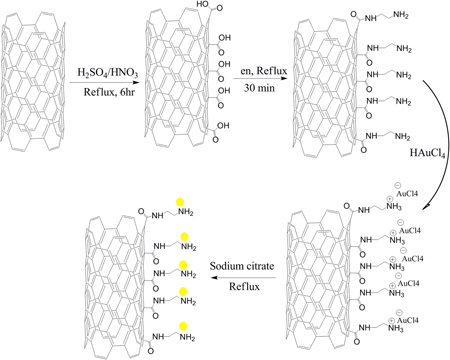Published online by Cambridge University Press: 09 September 2016

Herein, we present a method for decorating multi-walled carbon nanotubes (MWCNTs) with gold nanoparticles (AuNPs) using ethylenediamine (en) as a linker between MWCNTs and AuNPs. The amine group in en is as growth points for synthesis of AuNPs through electrostatic attraction between the amine groups and
 ${\rm{AuCl}}_4^ -$
anion while sodium citrate act as reducing agent. The influence of HAuCl4 concentration on the size and distribution of AuNPs in the structure of the Au-decorated nanotubes were investigated. Morphology of the decorated nanotubes was characterized by field emission scanning electron microscopy and transmission electron microscopy while the elemental composition of the decorated tubes and crystallography were investigated by energy dispersive x-ray, x-ray diffraction, Raman spectroscopy, and Fourier transform infrared techniques. Cyclic voltammetric and electrochemical impedance spectroscopic analysis revealed that the Au-decorated nanotubes have increased the electro-active surface area and conductivity of electrochemical substrate.
${\rm{AuCl}}_4^ -$
anion while sodium citrate act as reducing agent. The influence of HAuCl4 concentration on the size and distribution of AuNPs in the structure of the Au-decorated nanotubes were investigated. Morphology of the decorated nanotubes was characterized by field emission scanning electron microscopy and transmission electron microscopy while the elemental composition of the decorated tubes and crystallography were investigated by energy dispersive x-ray, x-ray diffraction, Raman spectroscopy, and Fourier transform infrared techniques. Cyclic voltammetric and electrochemical impedance spectroscopic analysis revealed that the Au-decorated nanotubes have increased the electro-active surface area and conductivity of electrochemical substrate.